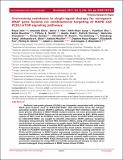| dc.contributor.author | Jain, Payal | en_US |
| dc.contributor.author | Silva, Amanda | en_US |
| dc.contributor.author | Han, Harry J. | en_US |
| dc.contributor.author | Lang, Shih-Shan | en_US |
| dc.contributor.author | Zhu, Yuankun | en_US |
| dc.contributor.author | Boucher, Katie | en_US |
| dc.contributor.author | Smith, Tiffany E. | en_US |
| dc.contributor.author | Vakil, Aesha | en_US |
| dc.contributor.author | Diviney, Patrick | en_US |
| dc.contributor.author | Choudhari, Namrata | en_US |
| dc.contributor.author | Raman, Pichai | en_US |
| dc.contributor.author | Busch, Christine M. | en_US |
| dc.contributor.author | Delaney, Tim | en_US |
| dc.contributor.author | Yang, Xiaodong | en_US |
| dc.contributor.author | Olow, Aleksandra K. | en_US |
| dc.contributor.author | Mueller, Sabine | en_US |
| dc.contributor.author | Haas-Kogan, Daphne | en_US |
| dc.contributor.author | Fox, Elizabeth | en_US |
| dc.contributor.author | Storm, Phillip B. | en_US |
| dc.contributor.author | Resnick, Adam C. | en_US |
| dc.contributor.author | Waanders, Angela J. | en_US |
| dc.date.accessioned | 2017-12-06T16:20:07Z | |
| dc.date.issued | 2017 | en_US |
| dc.identifier.citation | Jain, P., A. Silva, H. J. Han, S. Lang, Y. Zhu, K. Boucher, T. E. Smith, et al. 2017. “Overcoming resistance to single-agent therapy for oncogenic BRAF gene fusions via combinatorial targeting of MAPK and PI3K/mTOR signaling pathways.” Oncotarget 8 (49): 84697-84713. doi:10.18632/oncotarget.20949. http://dx.doi.org/10.18632/oncotarget.20949. | en |
| dc.identifier.issn | | en |
| dc.identifier.uri | http://nrs.harvard.edu/urn-3:HUL.InstRepos:34493164 | |
| dc.description.abstract | Pediatric low-grade gliomas (PLGGs) are frequently associated with activating BRAF gene fusions, such as KIAA1549-BRAF, that aberrantly drive the mitogen activated protein kinase (MAPK) pathway. Although RAF inhibitors (RAFi) have been proven effective in BRAF-V600E mutant tumors, we have previously shown how the KIAA1549-BRAF fusion can be paradoxically activated by RAFi. While newer classes of RAFi, such as PLX8394, have now been shown to inhibit MAPK activation by KIAA1549-BRAF, we sought to identify alternative MAPK pathway targeting strategies using clinically relevant MEK inhibitors (MEKi), along with potential escape mechanisms of acquired resistance to single-agent MAPK pathway therapies. We demonstrate effectiveness of multiple MEKi against diverse BRAF-fusions with novel N-terminal partners, with trametinib being the most potent. However, resistance to MEKi or PLX8394 develops via increased RTK expression causing activation of PI3K/mTOR pathway in BRAF-fusion expressing resistant clones. To circumvent acquired resistance, we show potency of combinatorial targeting with trametinib and everolimus, an mTOR inhibitor (mTORi) against multiple BRAF-fusions. While single-agent mTORi and MEKi PLGG clinical trials are underway, our study provides preclinical rationales for using MEKi and mTORi combinatorial therapy to stave off or prevent emergent drug-resistance in BRAF-fusion driven PLGGs. | en |
| dc.language.iso | en_US | en |
| dc.publisher | Impact Journals LLC | en |
| dc.relation.isversionof | doi:10.18632/oncotarget.20949 | en |
| dc.relation.hasversion | http://www.ncbi.nlm.nih.gov/pmc/articles/PMC5689567/pdf/ | en |
| dash.license | LAA | en_US |
| dc.subject | pediatric low-grade glioma | en |
| dc.subject | BRAF-fusions | en |
| dc.subject | trametinib and everolimus | en |
| dc.subject | MAPK pathway | en |
| dc.subject | PI3K/mTOR pathway | en |
| dc.title | Overcoming resistance to single-agent therapy for oncogenic BRAF gene fusions via combinatorial targeting of MAPK and PI3K/mTOR signaling pathways | en |
| dc.type | Journal Article | en_US |
| dc.description.version | Version of Record | en |
| dc.relation.journal | Oncotarget | en |
| dash.depositing.author | Haas-Kogan, Daphne | en_US |
| dc.date.available | 2017-12-06T16:20:07Z | |
| dc.identifier.doi | 10.18632/oncotarget.20949 | * |
| dash.authorsordered | false | |
| dash.contributor.affiliated | Haas-Kogan, Daphne | |


